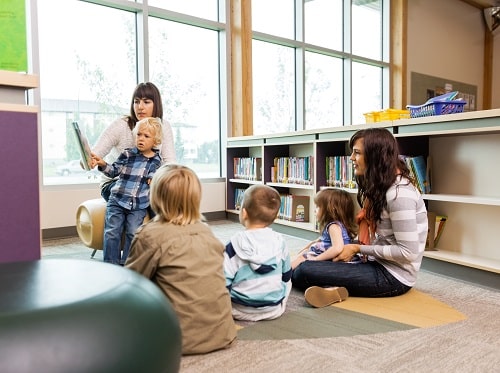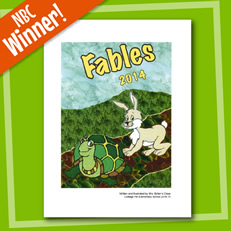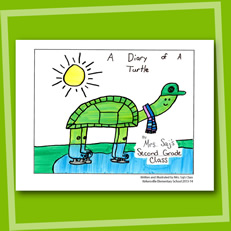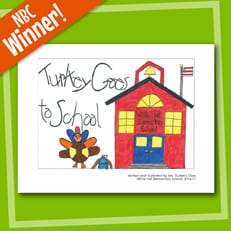 Kids’ books may not be the first thing that comes to mind when talking about high art or classic literature, but I’ve always found children’s story books to be among the most compelling methods of storytelling out there. Balanced perfectly at the crossroads between visual art and writing, they’re a great way to inspire kids to fall in love—both with the stories within, and the art of telling their own.
Kids’ books may not be the first thing that comes to mind when talking about high art or classic literature, but I’ve always found children’s story books to be among the most compelling methods of storytelling out there. Balanced perfectly at the crossroads between visual art and writing, they’re a great way to inspire kids to fall in love—both with the stories within, and the art of telling their own.
A narrative story book is a special kind of classbook project. Both structure and content depend heavily on the level of collaboration involved. Here are ideas for creating and publishing three very different types of story books with your elementary school students, ranging from individual projects to one big collaborative endeavor.
Idea #1: Anecdotal Anthology
 Just because it’s a “story book” doesn’t mean it has to be all about a single story. Why not create a class anthology instead? This project idea combines collaboration with independent work and allows each of your elementary students a chance to let their own ideas shine alongside those of their classmates.
Just because it’s a “story book” doesn’t mean it has to be all about a single story. Why not create a class anthology instead? This project idea combines collaboration with independent work and allows each of your elementary students a chance to let their own ideas shine alongside those of their classmates.
Begin by brainstorming ideas together as a class to decide on a topic and/or theme for your book. This overarching idea will be the glue that binds their stories together, no matter how different their plots or characters may be. Allow your students to then work separately, each writing and illustrating their own original story based on the theme the class chose. Make sure to include a proofreading step in your lesson plan to ensure their final drafts are polished to perfection before sending to the publisher to print. The result? A gorgeous collection of stories, each told in a different voice and from a unique perspective.
PROJECT IDEA
Mrs. Bollen’s class at Cottage Hill Elementary School created a stunning example of this type of story book when they published this collection of fables together in 2014.
Idea #2: Interwoven Tales
For a project with more balance between collaborative and individual work, consider publishing a classbook of  separate narrative stories that all connect in some way beyond merely falling under the same theme or tackling similar topics. Like puzzle pieces, each story can stand alone—but put them together, and something larger and even more beautiful emerges.
separate narrative stories that all connect in some way beyond merely falling under the same theme or tackling similar topics. Like puzzle pieces, each story can stand alone—but put them together, and something larger and even more beautiful emerges.
One easy way to accomplish this is to have your students all write stories featuring the same main character. You can even arrange these stories chronologically in the format of a diary or biography. Or, for a more creative twist, you can ask your students to take on the guise of a single storyteller spinning a whole book’s worth of yarns.
PROJECT IDEA
At Kirkersville Elementary School, Mrs. Saj’s 2nd grade class used this method to tell the story of a sweet and gentle little turtle through a series of journal entries written from the tiny reptile’s perspective.
Are you Enjoying this Content?
Idea #3: A Single Story
Finally, there’s the classic story book option: writing and illustrating a single continuous story from cover to cover. The best way to achieve this is to encourage collaboration at almost every stage of this elementary school project. Brainstorm the topic, theme, and major plot points together with the whole class. One easy way to make sure  nobody feels left out is to have each student add their own plot point to the list one at a time; this is the part of the story they will get to write. Number the plot points and make sure each student remembers their number as well as their plot point.
nobody feels left out is to have each student add their own plot point to the list one at a time; this is the part of the story they will get to write. Number the plot points and make sure each student remembers their number as well as their plot point.
Once they’ve completed a rough draft, provide them with an editing worksheet or two and have them peer edit each other’s stories. Have them pass their stories to the person whose number comes before theirs, then ask them to give their stories to the person whose number comes next. This gives them an idea of what comes before and after their section of the story, and they can use this knowledge to inform their revisions once they get their edited papers back.
Once final drafts and individual illustrations are complete, you can add a final magical touch of teamwork to your story book by asking your students to create a cover image together. In the end, the pages of your published classbook won’t just contain an imaginative story—they’ll hold the memories of the time your students spent working together to achieve something wonderful.
PROJECT IDEA
Mrs. Durbin’s class at White Hall Elementary School created a lovely Thanksgiving-themed story book of this type that tells the story of a clever turkey named Turbo and his adventures in attending a human elementary school.
Publishing Your Collaborative Story Book
In children’s story books, the main characters always learn a valuable lesson they will carry with them for the rest of their lives. Likewise, the most important part of your students’ elementary school story book project is what they learn along the way while making it. One of the most important lessons they can learn is simply to believe in themselves. As the saying goes, “seeing is believing”—and what better way to show them what they are truly capable of than by publishing their work just like “real writers”?
Becoming published authors helps build your students’ self-confidence by providing them with physical proof of their accomplishment and an easy means of sharing their work with others.
For more writing and publishing classroom resources, please check out our online teacher’s lounge, and don’t forget to sign up for your free publishing kit!
Image sources: Lead image via Shutterstock user wavebreakmedia; Images 1, 2, 3 via OpenClipart.org








